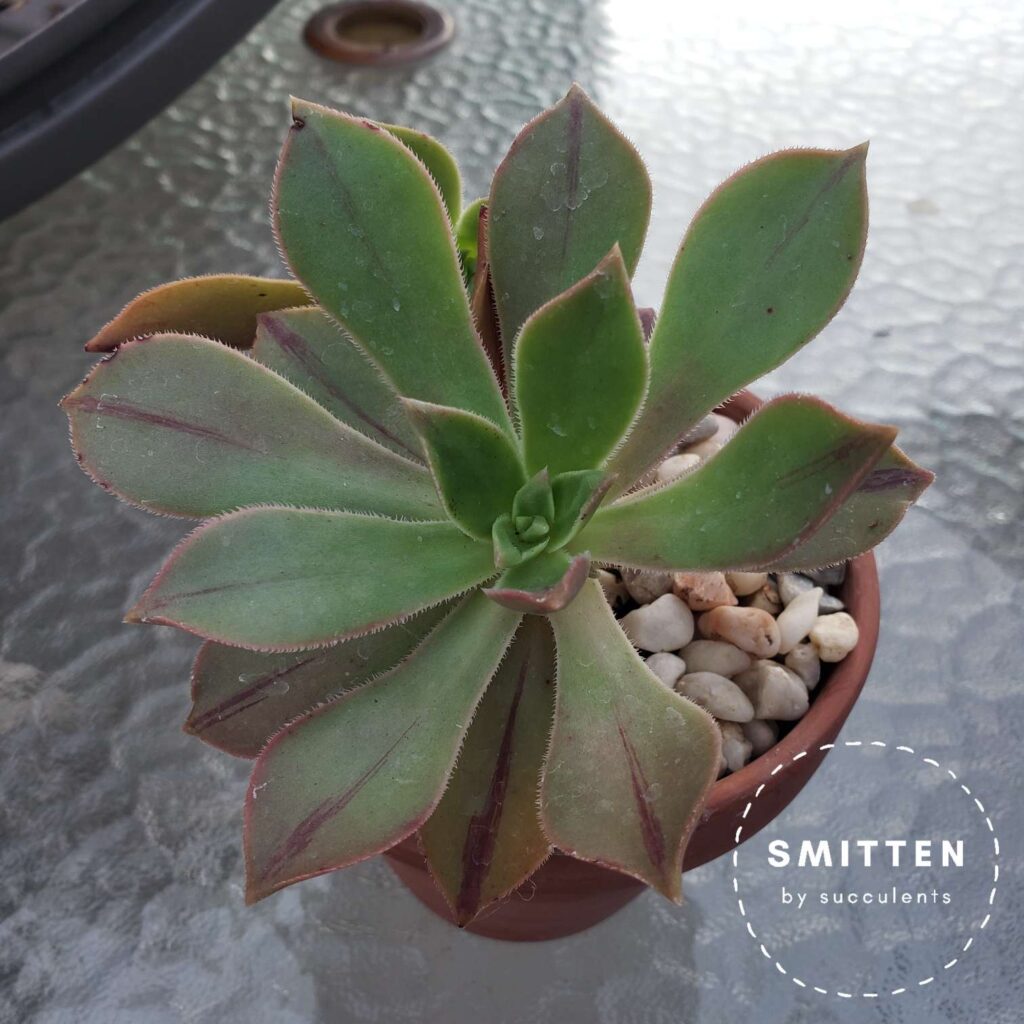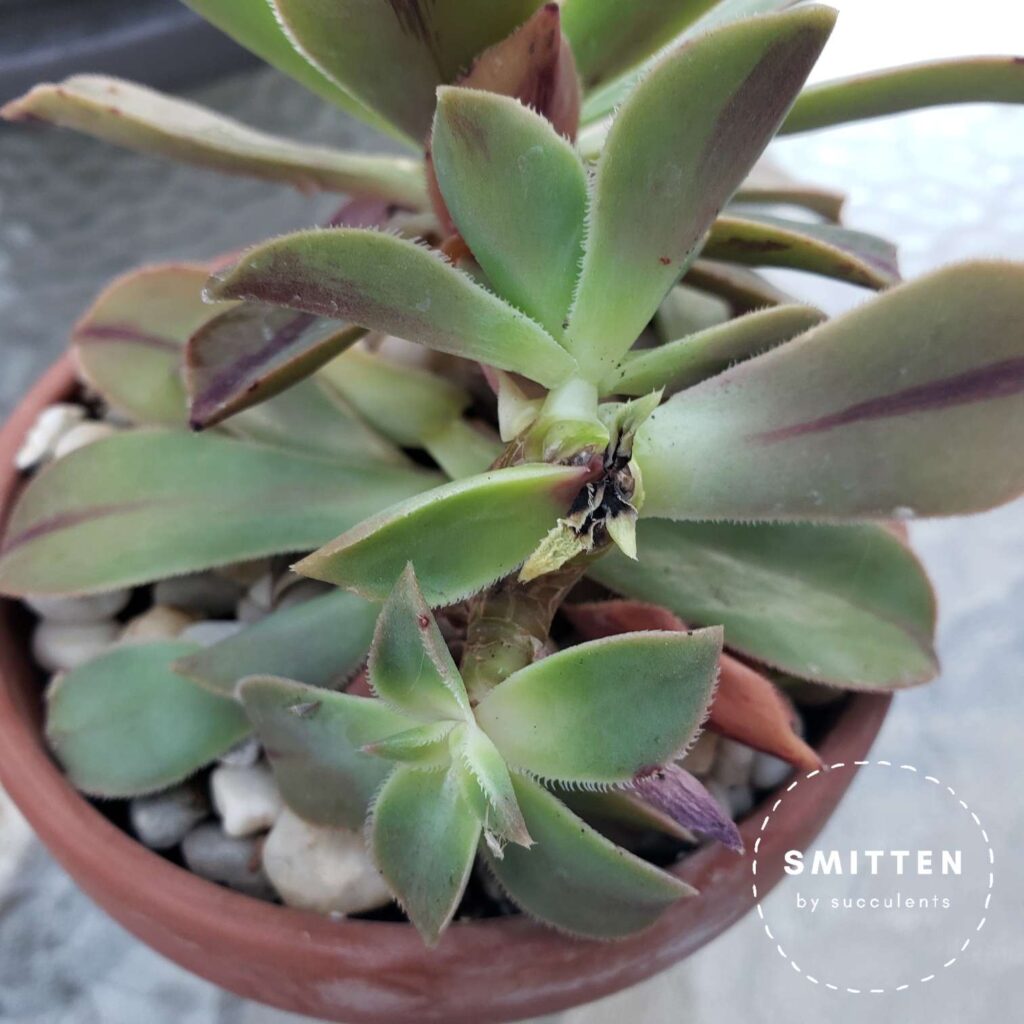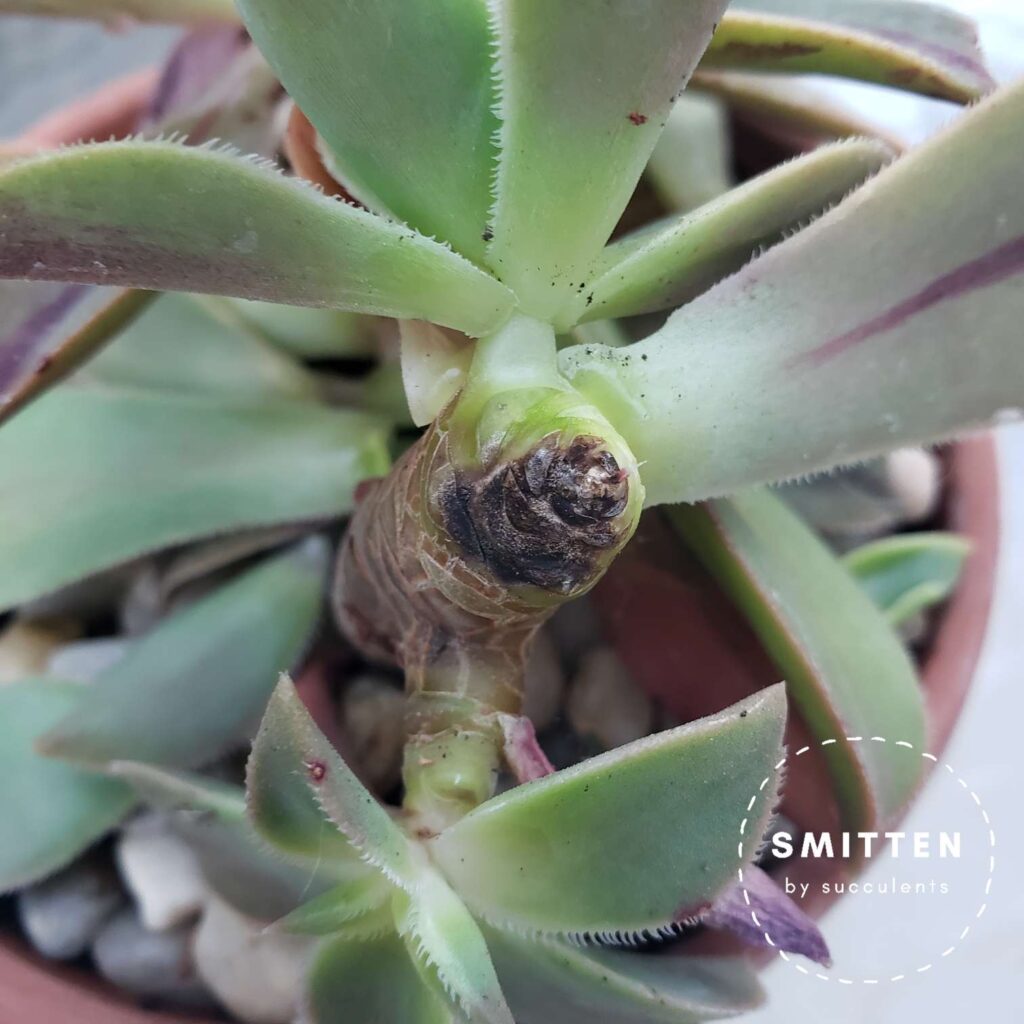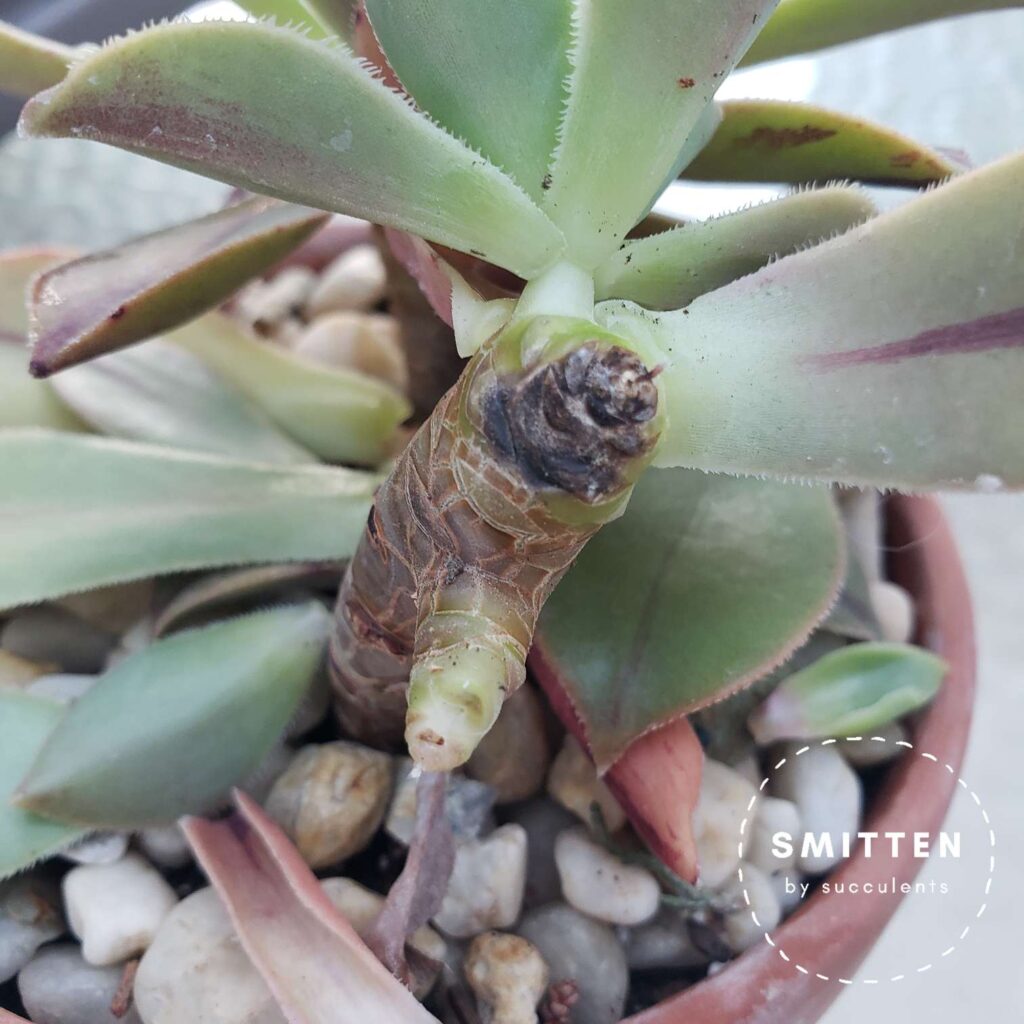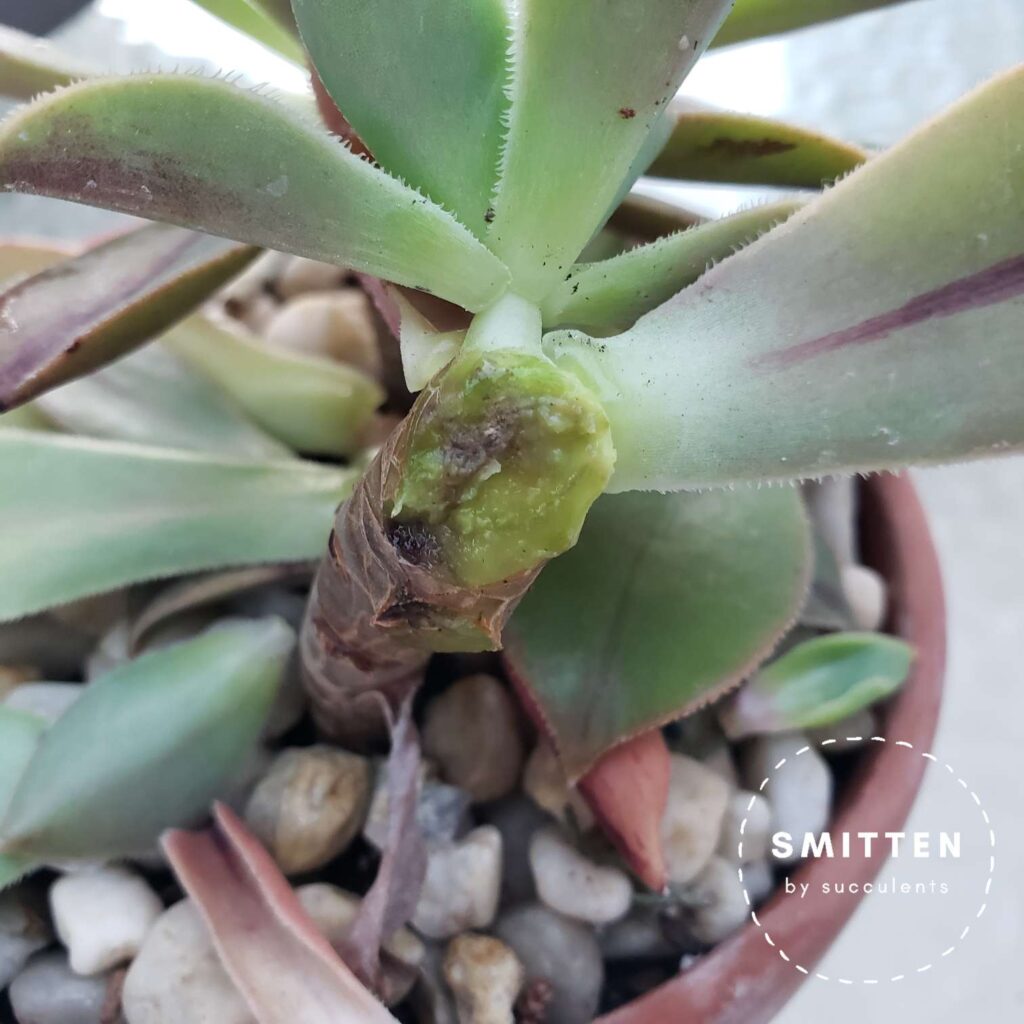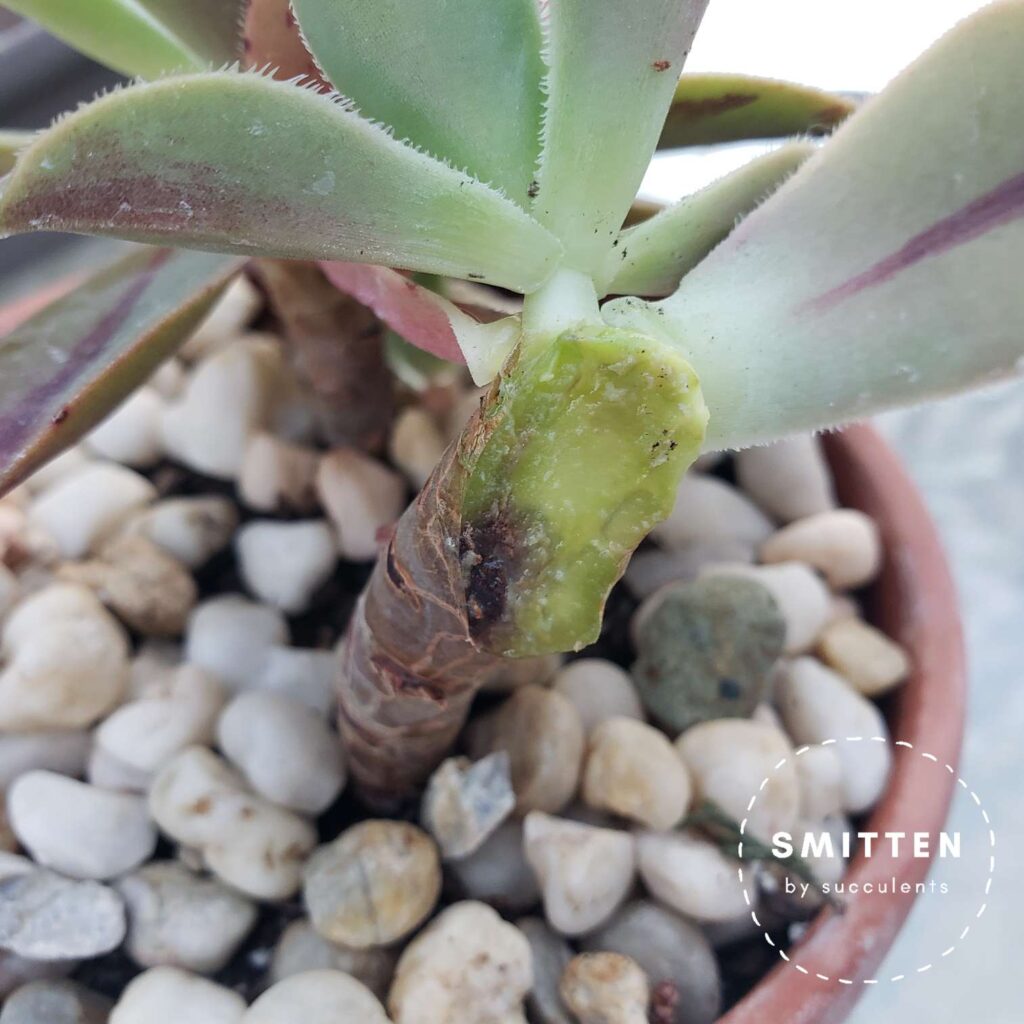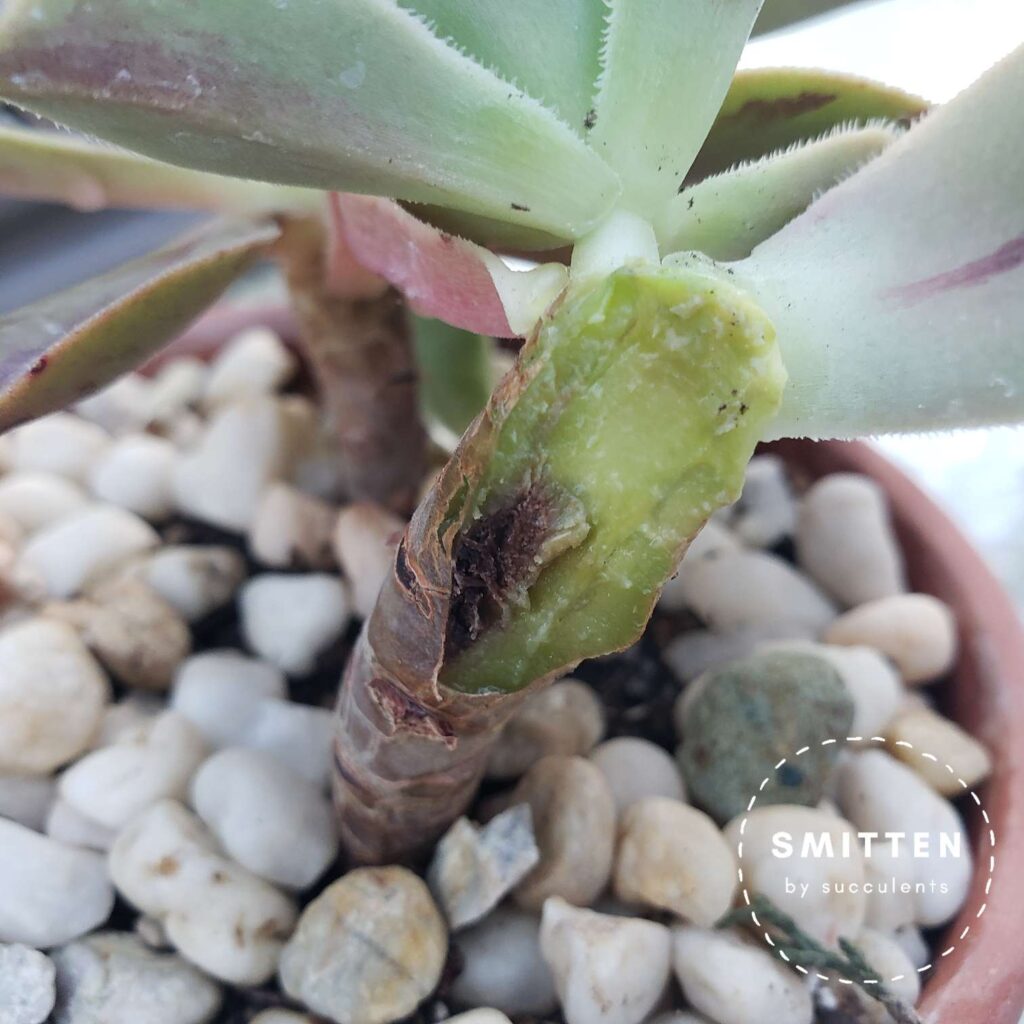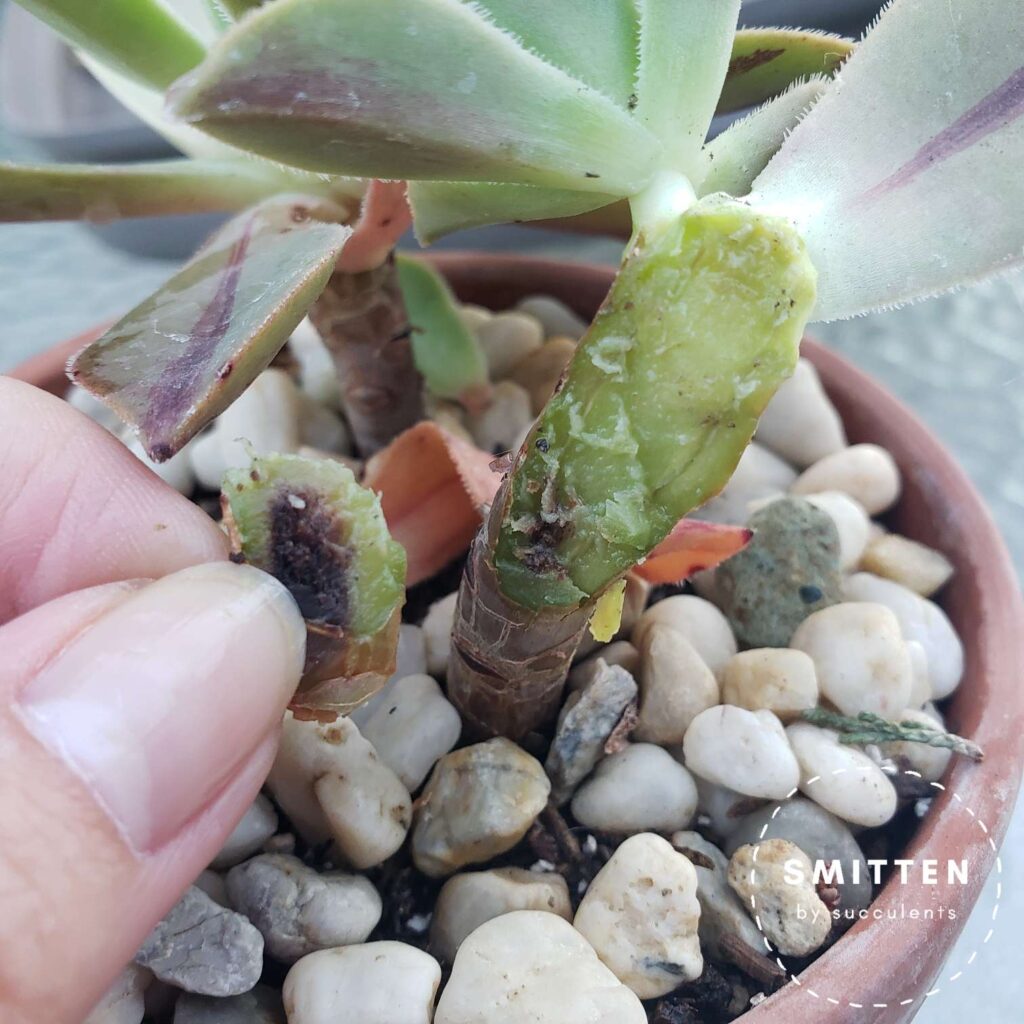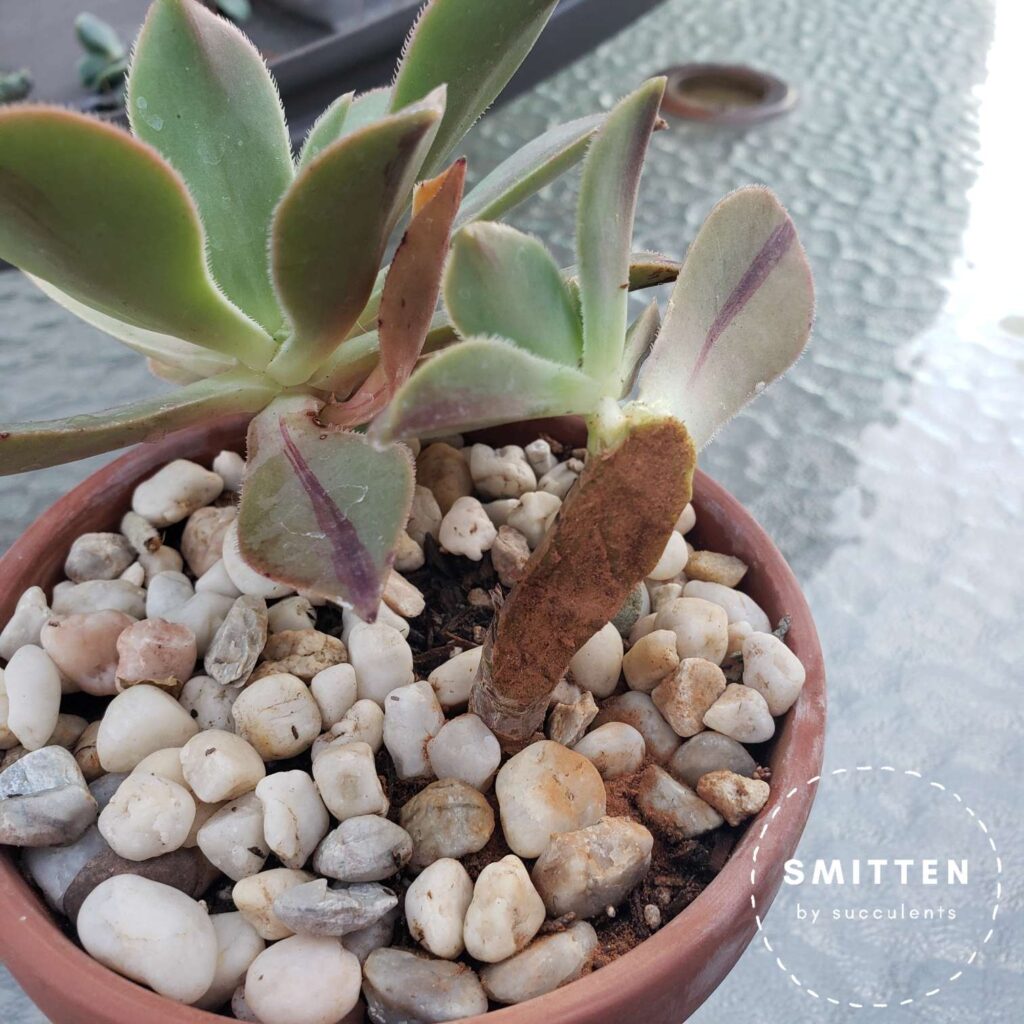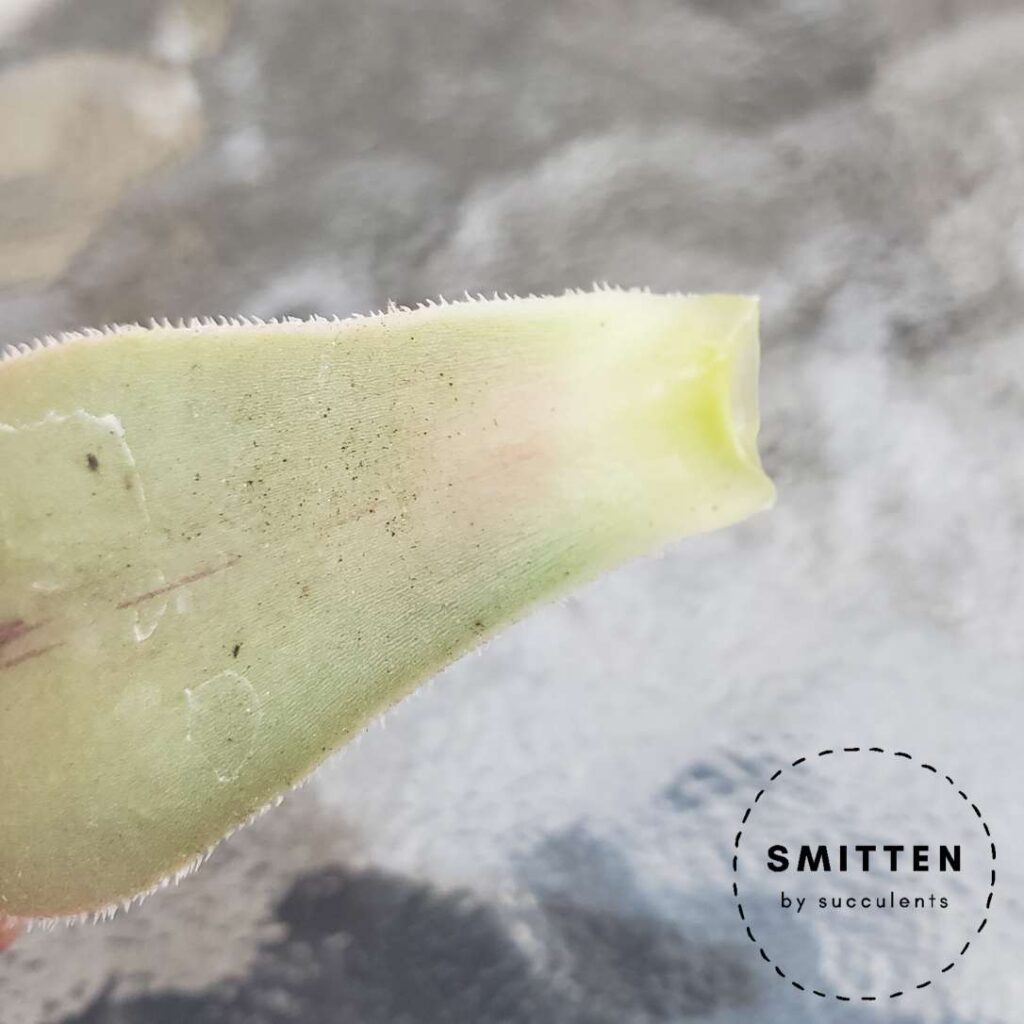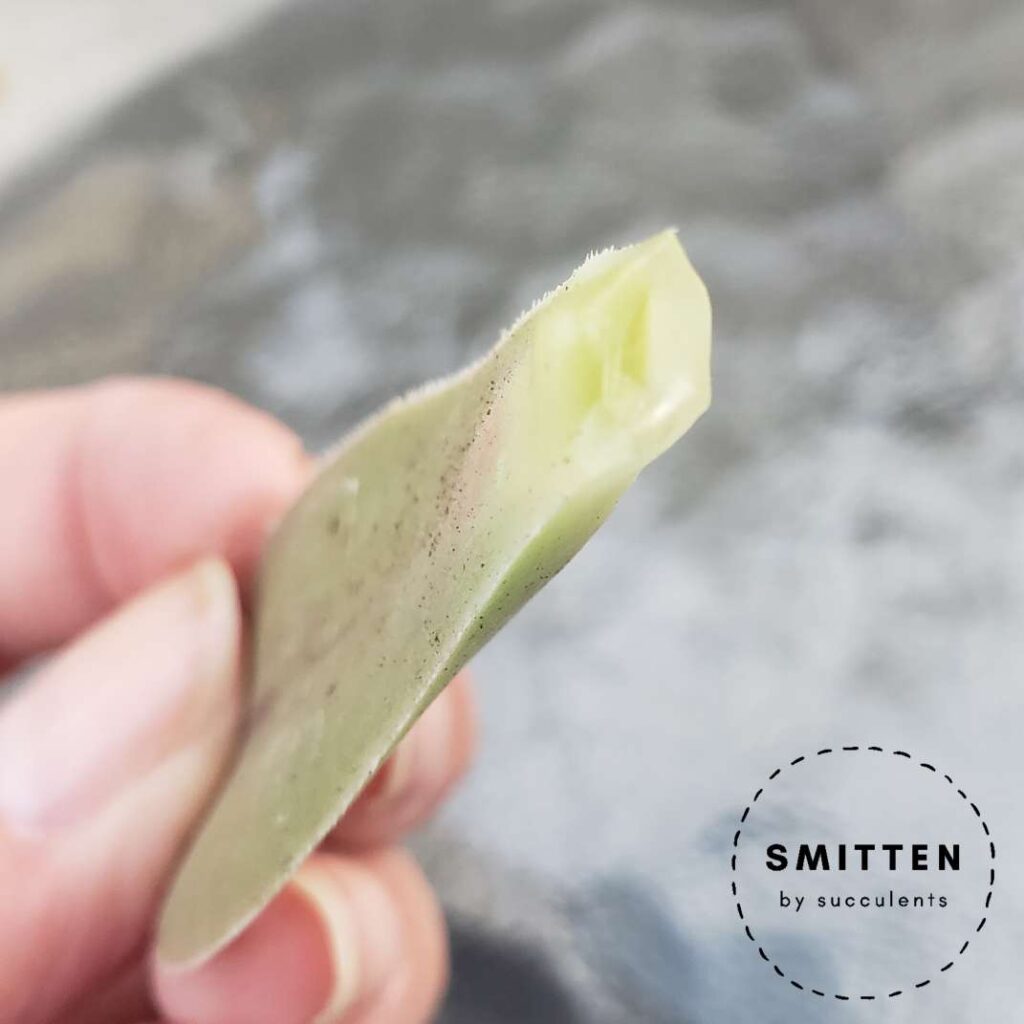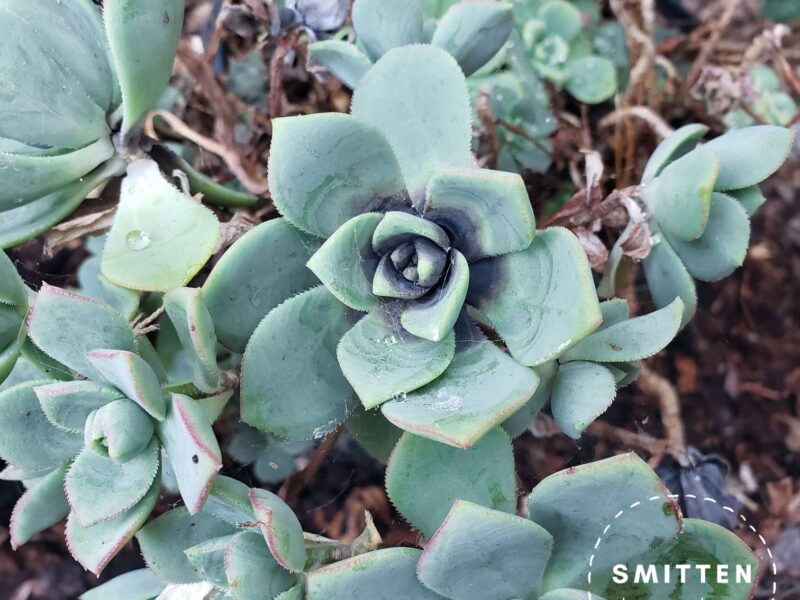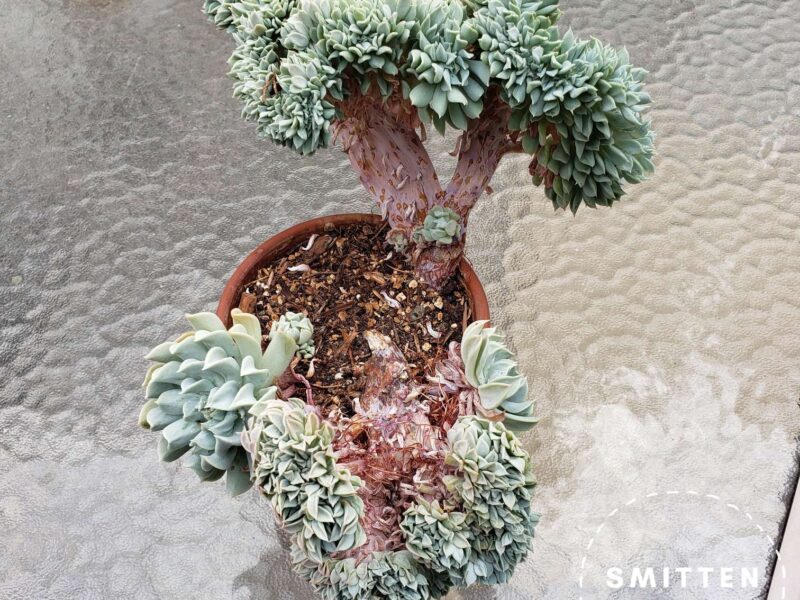Do you suspect that your succulent is rotting? Perhaps from overwatering? Are you looking for an example of rot on your succulent?
Well my friend, you have come to the right place. This post focuses on how to identify and remove rot from an Aeonium Leucoblepharum.
The first disclaimer is that not all rot looks the same. Plus, rot looks different on different types of succulents.
For some background, I purchased 2 cuttings of Aeonium Leucoblepharum in the spring, and I planted them together. They are now rooted, so they can take in water.
Today I found that one of these cuttings showed rot, and the other one (photographed here) looks okay (so far).
I will walk you through the clues of my succulent having issues.
The Signs of Rot
Sign 1: Dropped Leaves
One sign of an issue is dropped leaves. There are a lot of dropped leaves laying on the top of the pot. You can spot this issue from afar.
Note that these leaves look “healthy”. They’re not dry or shriveled up (although, they could be). Plus, they came from the rosette, not from the bottom of the plant. (When a healthy succulent loses leaves, it loses them from the bottom, not the top).
So if this rosette is facing away from you, and you see lots of dropped leaves, it may be that the plant is rotting or has another issue.
Sign 2: Leaves that drop easily
This is related to the first sign. If you gently touch or bump into the plant, and a leaf or multiple leaves fall off, that’s a sign that something is wrong.
Leaves should not pop off easily. If you want to remove a leaf (for example, for propagation), it should take some tugging.
Leaves that drop easily from a gentle touch is a sign that the plant has an issue such as overwatering or rotting.
Sign 3: Black on your plant
The color black is the most telltale sign. If you see black on your plant, it’s most likely rot.
Sometimes you have to remove leaves to see if your stem more closely and if it is, in fact, black.
If you look at the photo above, you can see black in the middle of the rosette. That is rot.
I listed this sign thirdly, even though it’s the most definitive, because I did not see it until I looked closer at the plant. The first 2 signs were my clues that something was wrong, and the black center confirmed it.
Sign 4: Soft Stem
Even though my Aeonium did not show this sign, this is another sign of rot. A soft, unfirm, or mushy stem is a sign of rot.
If I hadn’t caught the rot on this Aeonium, it would eventually weaken the whole stem and become soft. It wouldn’t be able to stand straight anymore. If there were any leaves still on it, it would bow to the weight. If you touched the soft area of the stem, it may even be mushy.
How to Remove Rot
If your succulent isn’t too rotted, you might be able to save it, and you can remove the rotted pieces. There is still a risk that your plant can continue to rot, so even after you removed the rotted pieces, you will need to observe it.
Since the rot (black part) didn’t look too large, it looked like I could excise it.
On this plant, there are 3 rosettes: the top, the main/middle, and the bottom rosette.
First I removed all the leaves from the main rosette to better see the extent of the rot. While I was doing that, I knocked off some leaves from the bottom rosette, which means it was also affected by rot. (The top rosette was still firm, so I left it as-is).
Since the bottom rosette is also infected, I also removed its leaves.
Next, I started to cut off the rot.
I used sharp and small scissors so that I could cut only what I needed to.
I cut off the main rosette’s stem and the bottom rosette’s stem.
With these initial cuts, you can still see some blackness (rot) inside the stem.
You can see I’m not the best cutter, and the cuts are rough.
I was trying to cut as little as possible at a time to reduce the damage to the plant. However, the rot was deeper than I thought.
The goal is to cut out all the rot.
In this photo, it looks like I cut a good chunk of the rot off, and there is less rot below.
This was my last cut because it looked like I removed all the rot. The stem looks all green.
I could have missed some, and there might be rot on the other side. However, since the top rosette did not show any of the signs of rot, I’m hoping it’s free of rot.
Lastly, I covered the wound with cinnamon. This acts as a bandage, so it’s more difficult for bugs, fungus, or bacteria to attack or infect it.
In a few days, the wound should scab over.
Now, I will observe the plant. The best case scenario would be that I successfully excised all the rot. The worst case is that I did not, and this effort was all for naught.
Can I propagate the leaves that were knocked off?
So back to the “leaves that drop easily” sign. Can you do something with those?
As of the time of falling off, these leaves look fairly healthy. There is no black anywhere. There is no withering.
However, I’m not convinced that these are healthy leaves that could potentially propagate. The ends look a bit translucent. This could be a sign of waterlogging. If they are waterlogged, in a few days, the ends will be rotted.
They would be worth keeping around for 5 days to see if they rot or if they are healthy. If there is no black within 5 days, I would say go ahead and try to propagate them! Side Note: Aeoniums can be difficult to propagate by leaves.
How did this plant rot?
This is my theory. I placed this Aeonium with my bigger Echeverias. Echeverias are active in the warmer seasons. Aeoniums are dormant in the warmer seasons and active in the cooler seasons.
It’s summer, and I have been watering my Echeveria weekly, and since I was watering them, I was on auto-pilot and watered this Aeonium as well. In other words, I overwatered the Aeonium. Being dormant, it cannot use all this water, and it rotted. (I should take my own advice and not water succulents on a schedule. I should check if the plant needs the water before I water it).
If I kept watering this Aeonium in this same pattern without noticing the rot, it would continue to rot, and its sibling would probably also rot.
If you have any questions about your plant or about rot, leave me a comment below, and I’ll help out as best I can!

